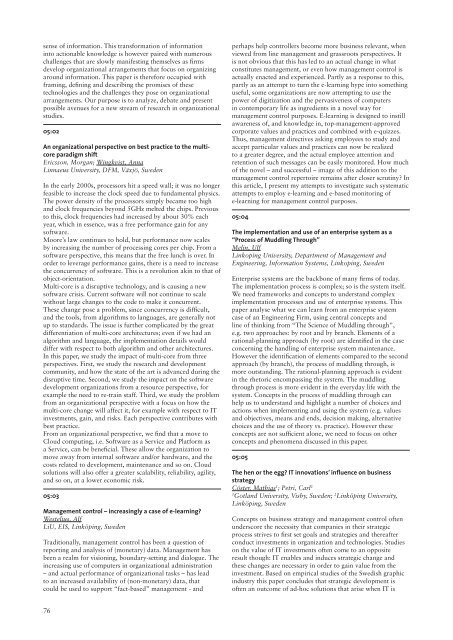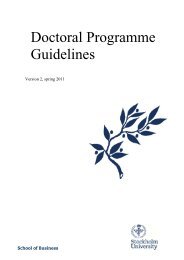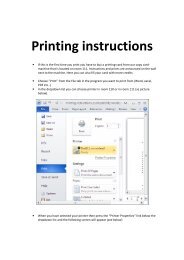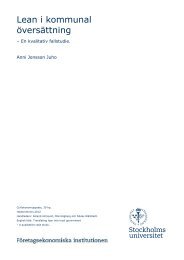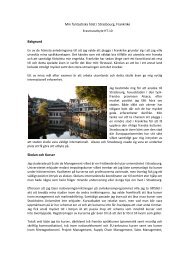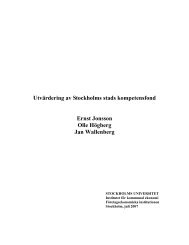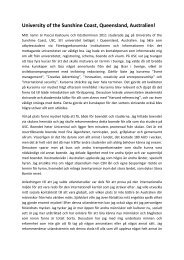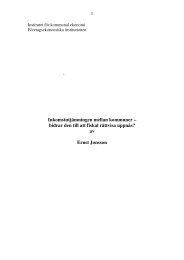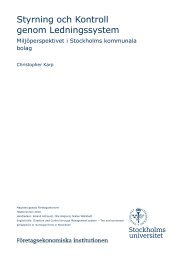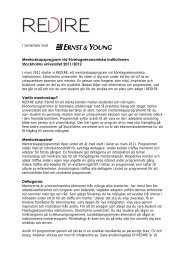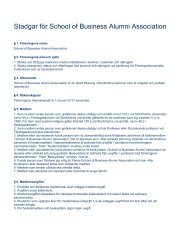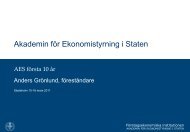Download full programme and abstract book pdf 1.6
Download full programme and abstract book pdf 1.6
Download full programme and abstract book pdf 1.6
You also want an ePaper? Increase the reach of your titles
YUMPU automatically turns print PDFs into web optimized ePapers that Google loves.
sense of information. This transformation of information<br />
into actionable knowledge is however paired with numerous<br />
challenges that are slowly manifesting themselves as firms<br />
develop organizational arrangements that focus on organizing<br />
around information. This paper is therefore occupied with<br />
framing, defining <strong>and</strong> describing the promises of these<br />
technologies <strong>and</strong> the challenges they pose on organizational<br />
arrangements. Our purpose is to analyze, debate <strong>and</strong> present<br />
possible avenues for a new stream of research in organizational<br />
studies.<br />
05:02<br />
An organizational perspective on best practice to the multicore<br />
paradigm shift<br />
Ericsson, Morgan; Wingkvist, Anna<br />
Linnaeus University, DFM, Växjö, Sweden<br />
In the early 2000s, processors hit a speed wall; it was no longer<br />
feasible to increase the clock speed due to fundamental physics.<br />
The power density of the processors simply became too high<br />
<strong>and</strong> clock frequencies beyond 5GHz melted the chips. Previous<br />
to this, clock frequencies had increased by about 30% each<br />
year, which in essence, was a free performance gain for any<br />
software.<br />
Moore’s law continues to hold, but performance now scales<br />
by increasing the number of processing cores per chip. From a<br />
software perspective, this means that the free lunch is over. In<br />
order to leverage performance gains, there is a need to increase<br />
the concurrency of software. This is a revolution akin to that of<br />
object-orientation.<br />
Multi-core is a disruptive technology, <strong>and</strong> is causing a new<br />
software crisis. Current software will not continue to scale<br />
without large changes to the code to make it concurrent.<br />
These change pose a problem, since concurrency is difficult,<br />
<strong>and</strong> the tools, from algorithms to languages, are generally not<br />
up to st<strong>and</strong>ards. The issue is further complicated by the great<br />
differentiation of multi-core architectures; even if we had an<br />
algorithm <strong>and</strong> language, the implementation details would<br />
differ with respect to both algorithm <strong>and</strong> other architectures.<br />
In this paper, we study the impact of multi-core from three<br />
perspectives. First, we study the research <strong>and</strong> development<br />
community, <strong>and</strong> how the state of the art is advanced during the<br />
disruptive time. Second, we study the impact on the software<br />
development organizations from a resource perspective, for<br />
example the need to re-train staff. Third, we study the problem<br />
from an organizational perspective with a focus on how the<br />
multi-core change will affect it, for example with respect to IT<br />
investments, gain, <strong>and</strong> risks. Each perspective contributes with<br />
best practice.<br />
From an organizational perspective, we find that a move to<br />
Cloud computing, i.e. Software as a Service <strong>and</strong> Platform as<br />
a Service, can be beneficial. These allow the organization to<br />
move away from internal software <strong>and</strong>/or hardware, <strong>and</strong> the<br />
costs related to development, maintenance <strong>and</strong> so on. Cloud<br />
solutions will also offer a greater scalability, reliability, agility,<br />
<strong>and</strong> so on, at a lower economic risk.<br />
05:03<br />
Management control – increasingly a case of e-learning?<br />
Westelius, Alf<br />
LiU, EIS, Linköping, Sweden<br />
Traditionally, management control has been a question of<br />
reporting <strong>and</strong> analysis of (monetary) data. Management has<br />
been a realm for visioning, boundary-setting <strong>and</strong> dialogue. The<br />
increasing use of computers in organizational administration<br />
– <strong>and</strong> actual performance of organizational tasks – has lead<br />
to an increased availability of (non-monetary) data, that<br />
could be used to support “fact-based” management - <strong>and</strong><br />
76<br />
perhaps help controllers become more business relevant, when<br />
viewed from line management <strong>and</strong> grassroots perspectives. It<br />
is not obvious that this has led to an actual change in what<br />
constitutes management, or even how management control is<br />
actually enacted <strong>and</strong> experienced. Partly as a response to this,<br />
partly as an attempt to turn the e-learning hype into something<br />
useful, some organizations are now attempting to use the<br />
power of digitization <strong>and</strong> the pervasiveness of computers<br />
in contemporary life as ingredients in a novel way for<br />
management control purposes. E-learning is designed to instill<br />
awareness of, <strong>and</strong> knowledge in, top-management-approved<br />
corporate values <strong>and</strong> practices <strong>and</strong> combined with e-quizzes.<br />
Thus, management directives asking employees to study <strong>and</strong><br />
accept particular values <strong>and</strong> practices can now be realized<br />
to a greater degree, <strong>and</strong> the actual employee attention <strong>and</strong><br />
retention of such messages can be easily monitored. How much<br />
of the novel – <strong>and</strong> successful – image of this addition to the<br />
management control repertoire remains after closer scrutiny? In<br />
this article, I present my attempts to investigate such systematic<br />
attempts to employ e-learning <strong>and</strong> e-based monitoring of<br />
e-learning for management control purposes.<br />
05:04<br />
The implementation <strong>and</strong> use of an enterprise system as a<br />
“Process of Muddling Through”<br />
Melin, Ulf<br />
Linkoping University, Department of Management <strong>and</strong><br />
Engineering, Information Systems, Linkoping, Sweden<br />
Enterprise systems are the backbone of many firms of today.<br />
The implementation process is complex; so is the system itself.<br />
We need frameworks <strong>and</strong> concepts to underst<strong>and</strong> complex<br />
implementation processes <strong>and</strong> use of enterprise systems. This<br />
paper analyse what we can learn from an enterprise system<br />
case of an Engineering Firm, using central concepts <strong>and</strong><br />
line of thinking from “The Science of Muddling through”,<br />
e.g. two approaches: by root <strong>and</strong> by branch. Elements of a<br />
rational-planning approach (by root) are identified in the case<br />
concerning the h<strong>and</strong>ling of enterprise system maintenance.<br />
However the identification of elements compared to the second<br />
approach (by branch), the process of muddling through, is<br />
more outst<strong>and</strong>ing. The rational-planning approach is evident<br />
in the rhetoric encompassing the system. The muddling<br />
through process is more evident in the everyday life with the<br />
system. Concepts in the process of muddling through can<br />
help us to underst<strong>and</strong> <strong>and</strong> highlight a number of choices <strong>and</strong><br />
actions when implementing <strong>and</strong> using the system (e.g. values<br />
<strong>and</strong> objectives, means <strong>and</strong> ends, decision making, alternative<br />
choices <strong>and</strong> the use of theory vs. practice). However these<br />
concepts are not sufficient alone, we need to focus on other<br />
concepts <strong>and</strong> phenomena discussed in this paper.<br />
05:05<br />
The hen or the egg? IT innovations’ influence on business<br />
strategy<br />
Cöster, Mathias1 ; Petri, Carl2 1 2 Gotl<strong>and</strong> University, Visby, Sweden; Linköping University,<br />
Linköping, Sweden<br />
Concepts on business strategy <strong>and</strong> management control often<br />
underscore the necessity that companies in their strategic<br />
process strives to first set goals <strong>and</strong> strategies <strong>and</strong> thereafter<br />
conduct investments in organization <strong>and</strong> technologies. Studies<br />
on the value of IT investments often come to an opposite<br />
result though: IT enables <strong>and</strong> induces strategic change <strong>and</strong><br />
these changes are necessary in order to gain value from the<br />
investment. Based on empirical studies of the Swedish graphic<br />
industry this paper concludes that strategic development is<br />
often an outcome of ad-hoc solutions that arise when IT is


